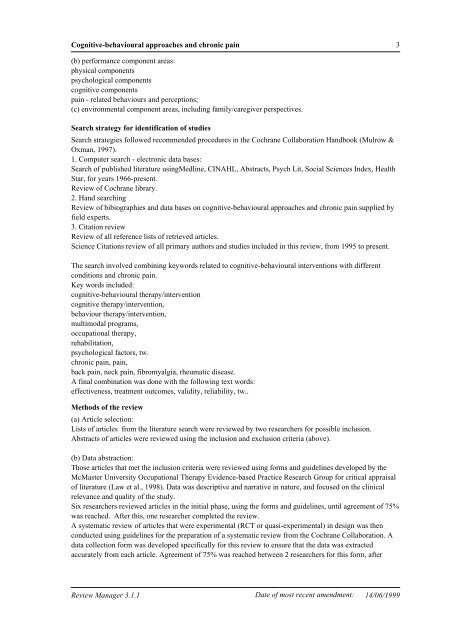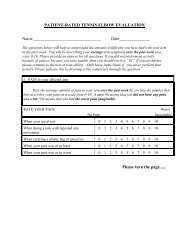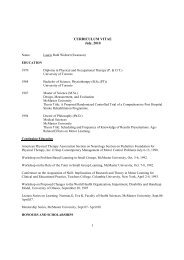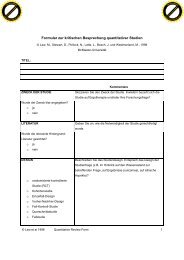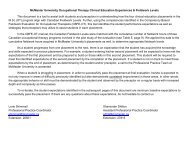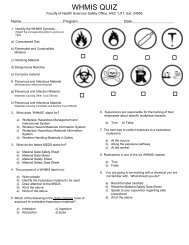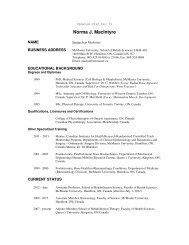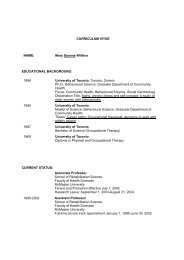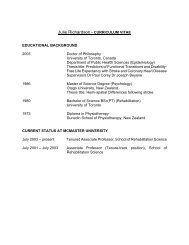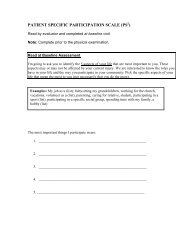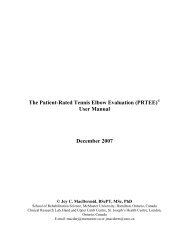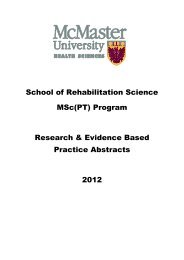The effectiveness of cognitive-behavioural interventions with people ...
The effectiveness of cognitive-behavioural interventions with people ...
The effectiveness of cognitive-behavioural interventions with people ...
You also want an ePaper? Increase the reach of your titles
YUMPU automatically turns print PDFs into web optimized ePapers that Google loves.
Cognitive-<strong>behavioural</strong> approaches and chronic pain 3(b) performance component areas:physical componentspsychological components<strong>cognitive</strong> componentspain - related behaviours and perceptions;(c) environmental component areas, including family/caregiver perspectives.Search strategy for identification <strong>of</strong> studiesSearch strategies followed recommended procedures in the Cochrane Collaboration Handbook (Mulrow &Oxman, 1997).1. Computer search - electronic data bases:Search <strong>of</strong> published literature usingMedline, CINAHL, Abstracts, Psych Lit, Social Sciences Index, HealthStar, for years 1966-present.Review <strong>of</strong> Cochrane library.2. Hand searchingReview <strong>of</strong> bibiographies and data bases on <strong>cognitive</strong>-<strong>behavioural</strong> approaches and chronic pain supplied byfield experts.3. Citation reviewReview <strong>of</strong> all reference lists <strong>of</strong> retrieved articles.Science Citations review <strong>of</strong> all primary authors and studies included in this review, from 1995 to present.<strong>The</strong> search involved combining keywords related to <strong>cognitive</strong>-<strong>behavioural</strong> <strong>interventions</strong> <strong>with</strong> differentconditions and chronic pain.Key words included:<strong>cognitive</strong>-<strong>behavioural</strong> therapy/intervention<strong>cognitive</strong> therapy/intervention,behaviour therapy/intervention,multimodal programs,occupational therapy,rehabilitation,psychological factors, tw.chronic pain, pain,back pain, neck pain, fibromyalgia, rheumatic disease.A final combination was done <strong>with</strong> the following text words:<strong>effectiveness</strong>, treatment outcomes, validity, reliability, tw..Methods <strong>of</strong> the review(a) Article selection:Lists <strong>of</strong> articles from the literature search were reviewed by two researchers for possible inclusion.Abstracts <strong>of</strong> articles were reviewed using the inclusion and exclusion criteria (above).(b) Data abstraction:Those articles that met the inclusion criteria were reviewed using forms and guidelines developed by theMcMaster University Occupational <strong>The</strong>rapy Evidence-based Practice Research Group for critical appraisal<strong>of</strong> literature (Law et al., 1998). Data was descriptive and narrative in nature, and focused on the clinicalrelevance and quality <strong>of</strong> the study.Six researchers reviewed articles in the initial phase, using the forms and guidelines, until agreement <strong>of</strong> 75%was reached. After this, one researcher completed the review.A systematic review <strong>of</strong> articles that were experimental (RCT or quasi-experimental) in design was thenconducted using guidelines for the preparation <strong>of</strong> a systematic review from the Cochrane Collaboration. Adata collection form was developed specifically for this review to ensure that the data was extractedaccurately from each article. Agreement <strong>of</strong> 75% was reached between 2 researchers for this form, afterReview Manager 3.1.1 Date <strong>of</strong> most recent amendment: 14/06/1999


